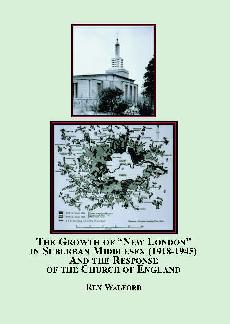This is our backup site. Click here to visit our main site at MellenPress.com
Growth of

| Author: | Rex Walford | |
| Year: | 2007 | |
| Pages: | 512 | |
| ISBN: | 0-7734-5352-0 978-0-7734-5352-4 | |
| Price: | $299.95 | |
This groundbreaking book sheds much-needed light on the neglected ecclesiastical history of urban England in the twentieth century. Working from detailed field evidence Rex Walford has investigated the fate of the Church of England in suburban Middlesex (“New London” north of the Thames) between the two World Wars. Quite contrary to a widely-held view, the Anglican Church flourished and expanded in this area during this time. More Anglican Churches than cinemas were built in the Diocese of London between 1918 and 1945 and many of them were significant in architecture, liturgy and new strategies of mission. The story of the genesis of The Forty-Five Churches Fund, of T.S. Eliot’s involvement with the Fund and the spread of new churches is accompanied by five detailed case-studies as well as a wealth of evidence from parishes which were created in these new suburban areas in the 1920s and 1930s. The book is copiously illustrated with maps and photographs and provides a highly readable narrative of an exciting period of church development, as well as a penetrating analysis of the myth of “secularization”. There are 24 black and white photos in this book.
Reviews
“Rex Walford’s timely and wide-ranging book is a rebuke to the laziness of this way of thinking about modern Britain ... This is a book that moves discussion of religion in modern Britain on from the rigidities of conventional arguments about secularization, and shows us brilliantly the contours of local religious development. It is not all a story of progress and growth, of course. Through his case studies, Rex Walford explores carefully reasons why some churches thrived whilst others struggled. But, in showing us so clearly the success of The Forty-Five Churches Fund and the life of many of the local churches it created, he adds a new dimension altogether to the history of the Church of England in the twentieth century, and to the history of modern Britain.” – Rev. Jeremy Morris, Dean, Trinity Hall, Cambridge University
“There are serious studies of the response of the churches to the rapid population growth of the 19th century but until Rex Walford’s work on the Church of England’s inter-war church building and parish planting strategy in the sprouting suburbs of Middlesex there has been very little reflection of 20th century developments.” – The Rt. Rev.and Rt. Hon. Richard Chartres, D.D., F.S.A., Bishop of London
“This is an extraordinarily successful piece of work which deals with the rather unfashionable, and consequently neglected, subject of church-building in the suburbs, in this case London’s ‘Metroland’ between the Wars.” – Dr. John Pollard, Fellow in History, Trinity Hall, Cambridge University
“There are serious studies of the response of the churches to the rapid population growth of the 19th century but until Rex Walford’s work on the Church of England’s inter-war church building and parish planting strategy in the sprouting suburbs of Middlesex there has been very little reflection of 20th century developments.” – The Rt. Rev.and Rt. Hon. Richard Chartres, D.D., F.S.A., Bishop of London
“This is an extraordinarily successful piece of work which deals with the rather unfashionable, and consequently neglected, subject of church-building in the suburbs, in this case London’s ‘Metroland’ between the Wars.” – Dr. John Pollard, Fellow in History, Trinity Hall, Cambridge University
Table of Contents
List of Figures
List of Illustrations
List of Tables
Preface by Rev. Dr. Jeremy Morris
Foreword by Rt. Rev. Richard Chartres, Bishop of London
Acknowledgements
1 The Secularization Myth
2 The Background to the Inter-War Years
3 The Expansion of the Middlesex Suburbs (“New London, North of the Thames”) 1918-1939
4 The Response of the Church of England to the Growth of “New London”
5 The Forty-Five Churches Fund
6 Five Case-Studies
7 Strategies of Mission in the Inter-War Suburbs – The Geographical Aspects
8 Strategies of Mission in the Inter-War Suburbs – Other Aspects
9 The Overall Response: Assessing the Extent of “Success” for the Church of England in the Expanding Suburbs of Middlesex, 1918-1945
10 Summary and Conclusion
Appendices
Bibliography
General Index
Churches Index
1 The Secularization Myth
2 The Background to the Inter-War Years
3 The Expansion of the Middlesex Suburbs (“New London, North of the Thames”) 1918-1939
4 The Response of the Church of England to the Growth of “New London”
5 The Forty-Five Churches Fund
6 Five Case-Studies
7 Strategies of Mission in the Inter-War Suburbs – The Geographical Aspects
8 Strategies of Mission in the Inter-War Suburbs – Other Aspects
9 The Overall Response: Assessing the Extent of “Success” for the Church of England in the Expanding Suburbs of Middlesex, 1918-1945
10 Summary and Conclusion
Appendices
Bibliography
General Index
Churches Index
